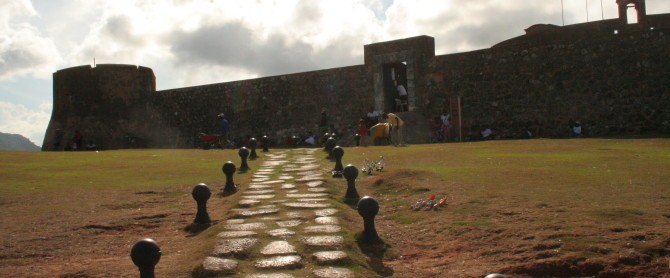San Felipe de Puerto Plata, Puerto Plata
San Felipe de Puerto Plata
History
The so-called Bride of the Atlantic was founded en the year 1502 by Nicolas de Ovando. The city of Puerto Plata was designed by the brothers Cristóbal and Bartolomé Colón as a seaport.
In colonial times it was considered the main maritime and commercial port of Hispaniola, but later it was demolished by order of Fernando III, to prevent the growth of piracy on the island.
Families from the Canary Islands repopulated the city again around the years 1700. During the period of 1822 al 1844 the city was dominated by Haitians, but from the National Independence in 1844 the city regains its commercial and maritime boom.
During the Restoration War 1863, the city was burned. Starting from 1865 the construction of the current city of Puerto Plata began. The city of great economic importance, maritime, social y cultural.
During the government of General Gregory Luperon became the capital of the Dominican Republic and today is the capital of the province of Puerto Plata, and is one of the most important commercial ports in the country. It is also the center of government and economic activity., with varied functions between the state sector, industrial, tourist, commercial, agriculture and services.
Geography
Located between Loma Isabel de Torres and the Atlantic Ocean, bordered on the north by the Atlantic Ocean; to the south through the Municipality of Altamira; to the west by the municipalities of Imbert and Luperón; and to the east by the municipality of Sosúa. To the south and southwest is the Loma Isabel de Torres.
The capital of Puerto Plata is also the owner of several rivers that run through the city, among these are Camú, Saint Mark, corozo, Muñoz, Maimon, the violin the mameyes , San Pinez and Rio Seco, as well as the Fú streams, White, Horse, Culebra and San Cristobal; In addition, there are countless ravines and lagoons.
Population
In the city of San Felipe de Puerto Plata, approximately 50% of the population of the entire province with 118,282 inhabitants.
Climate
It has a pleasant and tropical climate, that does not present great variations between the seasons of the year. The hottest temperature is recorded in summer, specifically in the months of August and September
Economy
Its location between the sea and the mountains has allowed it to develop its commercial activity.
The city of San Felipe de Puerto Plata is supported by agricultural activities, industrial and tourist, What are your main sources of income today?, thus providing significant figures for the economic and social growth of the entire country. Other forms of income and economic development, that serve to support some segments of their population, are based on the dynamics of port activity, the craft, fishing and countless fabric and shoe stores. Exclusively, the port has a great impact on the provincial and national economy.
Tourism
The city of San Felipe de Puerto Plata is the cradle of the colonial zone of the province, with buildings built in a Victorian style, considered the most modern of the time.
The La Puntilla Lighthouse is also native to the city, built during the government of General Gregorio Luperón.
The Cathedral of San Felipe Apóstol that in 1999 it was converted into a cathedral when it was elevated to the category of diocese. Its foundation dates from 1502, but it wasn't until 1870, with the work of the priest Pedro Tomás de Mena, when the temple began to be built. Upon completion in 1879, had a beautiful facade, adorned with imported wood and showy zinc fodder.
Loma Isabel de Torres is south of the city of Puerto Plata, In the top of the mountain, which reaches a height of 855 m (2 mil 555 feet) above sea level, there is a statue of Christ the Redeemer, similar to that of Rio de Janeiro. To go up you have to use the Isabel de Torres Mountain funicular[ ](commonly known as The Cable Car) was inaugurated in 1975.
There is also the Plaza Independencia or Parque Central, which is one of the most attractive places with the greatest projection in Puerto Plata.. It is considered one of the most precious symbols of “Silver City”. It was one of the gifts to his people from General Luperón during the government he led in 1879.
Another place of interest in the city is the San Felipe Fortress, which was built in stone between the years 1560 and 1577, to protect the city from the incursions of French and English pirates and corsairs who continually terrorized its inhabitants.


